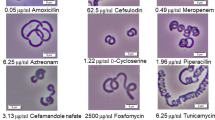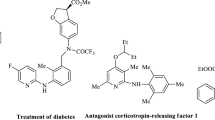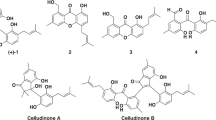Abstract
A new compound designated as clonoamide was isolated from a culture broth of the fungus Clonostachys sp. BF-0131 by solvent extraction, Diaion HP20 column chromatography, octadecylsilyl column chromatography and preparative HPLC as an inhibitor of sterol O-acyltransferase (SOAT). The structure of clonoamide was elucidated as 2-oxo-9E,11E-tridecandienyl acetamide by various spectral analyses including NMR. The compound inhibited SOAT1 and SOAT2 isozymes with IC50 values of 39 and 110 μm, respectively, in a cell-based assay using SOAT1- and SOAT2-expressing Chinese hamster ovary cells.
Similar content being viewed by others
Log in or create a free account to read this content
Gain free access to this article, as well as selected content from this journal and more on nature.com
or
References
Libby, P. The forgotten majority: unfinished business in cardiovascular risk reduction. J. Am. Coll. Cardiol. 46, 1225–1228 (2005).
Chang, C. C., Huh, H. Y., Cadigan, K. M. & Chang, T. Y. Molecular cloning and functional expression of human acyl-coenzyme A: cholesterol acyltransferase cDNA in mutant Chinese hamster ovary cells. J. Biol. Chem. 268, 20747–20755 (1993).
Anderson, R. A. et al. Identification of a form of acyl-CoA:cholesterol acyltransferase specific to liver and intestine in nonhuman primates. J. Biol. Chem. 273, 26747–26754 (1998).
Cases, S. et al. ACAT-2, a second mammalian acyl-CoA:cholesterol acyltransferase. Its cloning, expression, and characterization. J. Biol. Chem. 273, 26755–26764 (1998).
Oelkers, P., Behari, A., Cromley, D., Billheimer, J. T. & Sturley, S. L. Characterization of two human genes encoding acyl coenzyme A:cholesterol acyltransferase-related enzymes. J. Biol. Chem. 273, 26765–26771 (1998).
Lee, H. T. et al. Inhibitors of acyl-CoA: cholesterol O-acyltransferase (ACAT) as hypocholesterolemic agents. CI-1011: an acyl sulfamate with unique cholesterol-lowering activity in animals fed noncholesterol-supplemented diets. J. Med. Chem. 39, 5031–5034 (1996).
Terasaka, N. et al. ACAT inhibitor pactimibe sulfate (CS-505) reduces and stabilizes atherosclerotic lesions by cholesterol-lowering and direct effects in apolipoprotein E-deficient mice. Atherosclerosis 190, 239–247 (2007).
Ikenoya, M. et al. A selective ACAT-1 inhibitor, K-604, suppresses fatty streak lesions in fat-fed hamsters without affecting plasma cholesterol levels. Atherosclerosis 191, 290–297 (2007).
Buhman, K. K. et al. Resistance to diet-induced hypercholesterolemia and gallstone formation in ACAT2-deficient mice. Nat. Med. 6, 1341–1347 (2000).
Willner, E. L. et al. Deficiency of acyl CoA:choletsterol acyltransferase 2 prevents atherosclerosis in apolipoprotein E-deficient mice. Proc. Natl. Acad. Sci. USA 100, 1262–1267 (2003).
Ohshiro, T. et al. Pyripyropene A, an acyl-coenzyme A:cholesterol acyltransferase 2-selective inhibitor, attenuates hypercholesterolemia and atherosclerosis in murine models of hyperlipidemia. Artherioscler. Thromb. Vasc. Biol. 31, 1108–1115 (2011).
Ohshiro, T. & Tomoda, H. Acyltransferase inhibitors: a patent review (2010-present). Expert Opin. Ther. Pat. 25, 145–158 (2014).
Ohshiro, T. & Tomoda, H. Isoform-specific inhibitors of ACATs: recent advances and promising developments. Future Med. Chem. 3, 2039–2061 (2011).
Tomoda, H. & Ōmura, S. Potential therapeutics for obesity and atherosclerosis: inhibitors of neutral lipid metabolism from microorganisms. Pharmacol. Ther. 115, 375–389 (2007).
Shrecker, A. W. & Trail, M. M. Aminoketones. I. The preparation of α-aminoketones from Di-t-butyl acetamidomalonate. J. Am. Chem. Soc. 80, 6077–6080 (1958).
Gould, F. E., Johnson, G. S. & Ferris, A. F. The hydrogenation of nitriles to primary amines. J. Org. Chem. 25, 1658–1660 (1960).
O’brian, P. M. et al. Inhibitors of acyl-CoA:cholesterol O-acyltransferase. Synthesis and pharmacological activity of (+/−)-2-dodecyl-alpha-phenyl-N-(2,4,6-trimethoxyphenyl)-2H-tetrazole-5-acetamide and structurally related tetrazole amide derivatives. J. Med. Chem. 39, 2354–2366 (1996).
Murakami, S., Araki, H., Otomo, S., Nara, Y. & Yamori, Y. Effects of HL-004, a novel ACAT inhibitor, on cholesterol accumulation and removal in cultured smooth muscle cells from stroke-prone spontaneously hypertensive rats (SHRSP). Life Sci. 56, 509–520 (1995).
Junquero, D. et al. Pharmacological profile of F 12511, (S-2’,3’,5’-trimethyl-4’-hydroxy-alpha-dodecylthioacetanilide a powerful and systemic acylcoenzyme A: cholesterol acyltransferase inhibitor. Biochem. Pharmacol. 61, 97–108 (2001).
Ohshiro, T., Rudel, L. L., Ōmura, S. & Tomoda, H. Selectivity of microbial acyl-CoA:cholesterol acyltransferase inhibitors toward isozymes. J. Antibiot. 60, 43–51 (2007).
Namatame, I., Tomoda, H., Ishibashi, S. & Ōmura, S. Antiatherogenic activity of fungal beauveriolides, inhibitors of lipid droplet accumulation in macrophages. Proc. Natl. Acad. Sci. USA. 101, 737–742 (2004).
Lada, A. T. et al. Identification of ACAT1- and ACAT2-specific inhibitors using a novel, cell-based fluorescence assay: individual ACAT uniqueness. J. Lipid Res. 45, 378–386 (2004).
Bligh, E. G. & Dyer, W. A rapid method of total lipid extraction and purification. Can. J. Biochem. Physiol 37, 911–917 (1959).
Field, F. J., Cooper, A. D. & Erickson, S. K. Regulation of rabbit intestinal acyl coenzyme A-cholesterol acyltransferase in vivo and in vitro. Gastroenterology 83, 873–880 (1982).
Ohte, S. et al. Dinapinones, novel inhibitor of triacylglycerol synthesis in mammalian cells, produced by Penicillium pinophilum FKI-3864. J. Antibiot. 64, 489–494 (2011).
Namatame, I., Tomoda, H., Arai, H., Inoue, K. & Ōmura, S. Complete inhibition of mouse macrophage-derived foam cell formation by triacsin C. J. Biochem. 125, 319–327 (1999).
Acknowledgements
We wish to thank Ms Noriko Sato and Dr Kenichiro Nagai (School of Pharmaceutical Sciences, Kitasato University) for measurements of NMR spectra and MS data. This work was supported by a Grant-in-aid for Scientific Research (A) 26253009 from the Ministry of Education, Culture, Sports, Science and Technology, Japan (to HT).
Author information
Authors and Affiliations
Corresponding author
Rights and permissions
About this article
Cite this article
Kobayashi, K., Tsukasaki, N., Uchida, R. et al. Clonoamide, a new inhibitor of sterol O-acyltransferase, produced by Clonostachys sp. BF-0131. J Antibiot 68, 615–619 (2015). https://doi.org/10.1038/ja.2015.37
Received:
Revised:
Accepted:
Published:
Issue date:
DOI: https://doi.org/10.1038/ja.2015.37
This article is cited by
-
Anti-Rhizopus activity of tanzawaic acids produced by the hot spring-derived fungus Penicillium sp. BF-0005
The Journal of Antibiotics (2018)
-
A Mixture of Atropisomers Enhances Neutral Lipid Degradation in Mammalian Cells with Autophagy Induction
Scientific Reports (2018)
-
Pseudopyronine B, an inhibitor of sterol O-acyltransferase, produced by Pseudomonas sp. BYK11209
The Journal of Antibiotics (2017)



